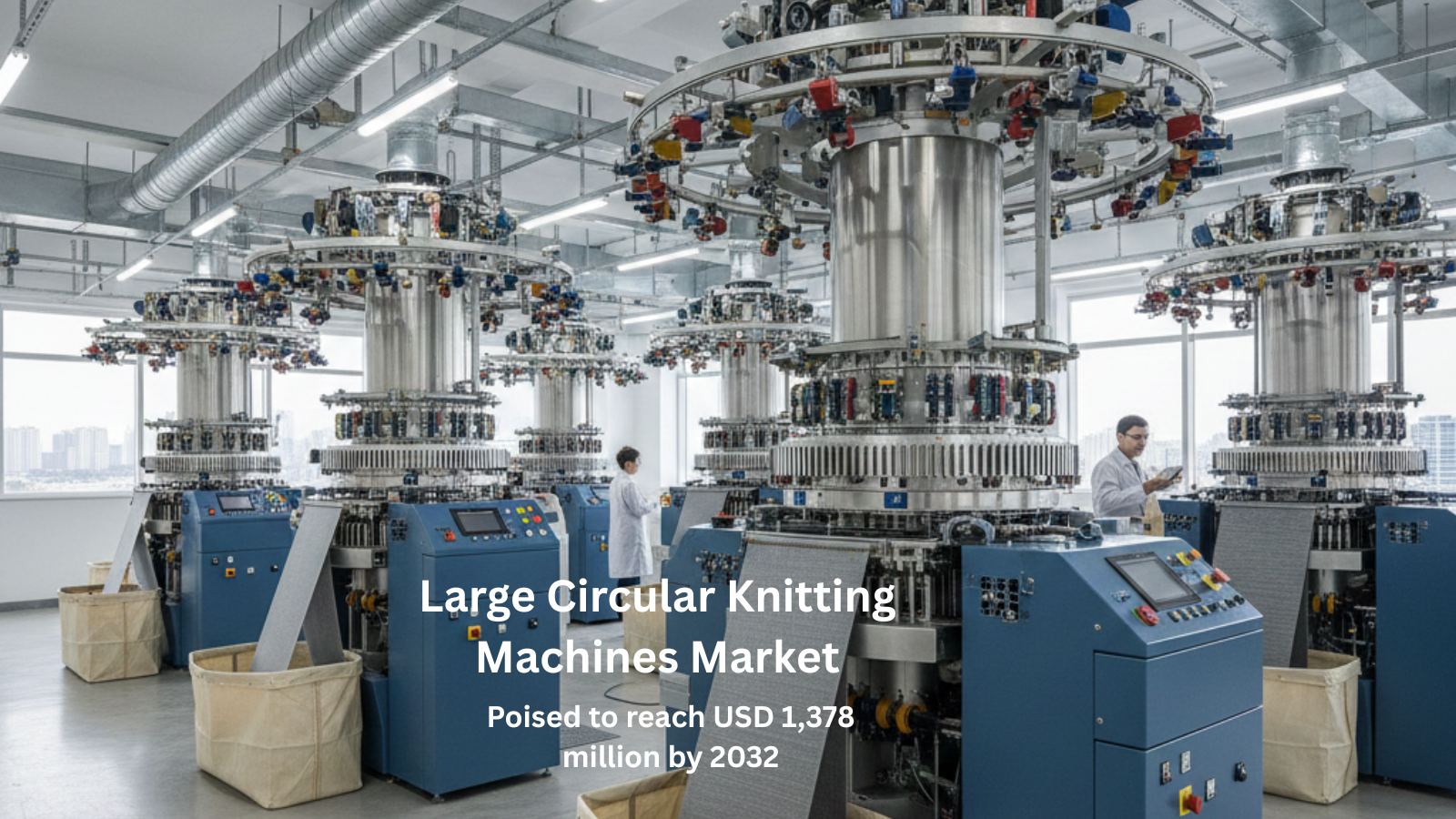
The global Large Circular Knitting Machine Market was valued at USD 1,076 million in 2024. It is projected to grow from USD 1,115 million in 2025 to USD 1,378 million by 2032, registering a CAGR of 3.7% during the forecast period.
Large circular knitting machines are industrial textile machines designed to produce tubular and seamless fabrics using circular needle arrangements. They manufacture a wide range of fabrics—such as single jersey, rib, and elastic materials—used in:
Apparel Textiles
Home Textiles
Technical Textiles
Growing consumption of knitted garments and the expanding use of specialty textiles (in automotive, healthcare, and wearables) are boosting the need for high-efficiency knitting machines.
Expanding use of knitted fabrics in:
Automotive interiors
Medical textiles
Smart textiles and wearables
Machines support natural, synthetic, and high-performance fibers.
Modern machines with IoT, automation, and real-time monitoring help manufacturers produce faster, reduce errors, and improve fabric quality, pushing mills to upgrade their equipment.
Fast Fashion Impact
Fast fashion requires quick turnaround and diverse fabric designs, making automated circular knitting machines essential for maintaining production speed and flexibility.
Sustainability Shift
Manufacturers prefer machines that support recycled yarns and reduce waste, aligning production with global sustainability goals.
The machines are expensive to purchase and maintain, especially for small manufacturers, making adoption difficult.
Operating these advanced machines requires skilled technicians, and the shortage of trained workers leads to inefficiencies and higher downtime.
Many global and regional players create strong competition, lowering margins and forcing companies to innovate continuously.
Fast fashion requires rapid production cycles and diverse design capabilities.
Growing preference for machines compatible with recycled yarns and sustainable manufacturing.
Textile demand is sensitive to economic downturns.
Prices of cotton, polyester, and other raw materials fluctuate, affecting profitability.
Compliance involves costs for:
Waste treatment
Energy efficiency certifications
Regulations may delay or limit new machinery investments.
Asia Pacific, Latin America, and Africa offer significant potential due to:
Expanding textile infrastructure
Lower labor costs
Strong domestic demand
High demand for textiles with:
Integrated sensors
Conductive yarns
Technical features
Machines capable of seamless smart textile production will see high adoption.
Machines capable of small-batch production and quick pattern changes are in demand.
Reduces waste while meeting brand needs for personalization.
Single Circular Knitting Machines (Dominant)
Double Circular Knitting Machines
Single machines are preferred for:
Smooth, single-layer tubular fabrics
High-volume apparel manufacturing
Cost efficiency and operational reliability
Apparel Textiles (Largest Segment)
Home Textiles
Technical Textiles
Others
Driven by global demand for:
T-shirts
Sportswear
Innerwear
Comfort-focused apparel
Large-Scale Textile Mills (Leading)
Independent Garment Manufacturers
Technical Textile Producers
Large mills dominate due to:
High productivity needs
Scale advantages
Large brand partnerships
Single Jersey (Largest)
Double Knit (Rib, Interlock)
Jacquard & Patterned Fabrics
Single jersey leads due to:
High consumption in daily wear
Low production cost
High efficiency on circular machines
Mechanically Controlled Machines
Electronically Controlled Machines (Dominant)
Fully Automated Production Lines
Electronic models dominate due to:
High precision
Better pattern capabilities
Lower labor dependency
The global large circular knitting machine market features key market players and numerous regional manufacturers. Leading brands such as Mayer & Cie., Santoni, Terrot, Pailung, and Baiyuan Machine focus heavily on:
Automation
Digital controls
Energy efficiency
High-speed production
Moderately concentrated among top players
High innovation intensity
Strong presence of Chinese and Taiwanese manufacturers offering cost-effective solutions
Mayer & Cie
Santoni
Terrot
Pailung
Baiyuan Machine
Fukuhara
Tayu
Orizio
Wellmade
Hang Xing
Hengyi
Hongji
Taifan
Sanda
Unitex
Market expected to reach USD 1,378 million by 2032.
Demand driven by high use in apparel, home textiles, and technical textiles.
China: 40% market share (largest)
Europe + North America: 40% combined
Remaining regions show rising interest in automation and textile exports.
Digital controls
Automated monitoring
Energy-efficient machines
Increasing customization capabilities
Strong manufacturing base
Industry 4.0 adoption accelerating
Dominance due to low production costs and local machine makers
Premium textile and technical textile production
Strong innovation and sustainability focus
Demand driven by reshoring and performance textiles
Investing heavily in automation
Growth led by Brazil and Colombia
Increasing modernization to compete in exports
Turkey leads due to export-oriented textile sector
Africa emerging slowly with cost-focused investments
The market was valued at USD 1,076 million in 2024 and is expected to reach USD 1,378 million by 2032, growing at a CAGR of 3.7%
Key companies include Pailung, Baiyuan Machine, Mayer & Cie, Terrot, and Santoni, all of which are known for advanced machinery, precision engineering, and strong global distribution.
China dominates the market with about 40% share, driven by its large-scale textile manufacturing capacity and integrated supply chains. Europe and North America together hold another 40%, reflecting strong demand for premium fabrics and technical textiles.
Single Circular Knitting Machines lead the market with approximately 65% share due to their efficiency in producing large volumes of single-jersey fabrics used widely in everyday apparel.
The Apparel Textiles segment is the largest, driven by continuous demand for knitted garments like T-shirts, sportswear, and underwear. The ability of circular knitting machines to create seamless, elastic, and comfortable fabrics makes them ideal for modern fashion production.